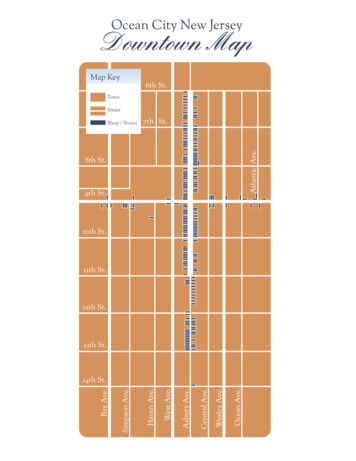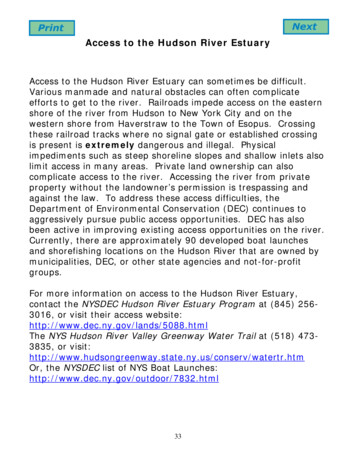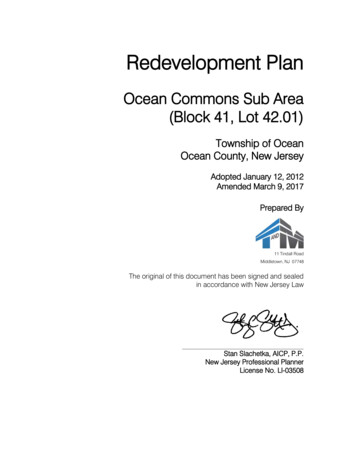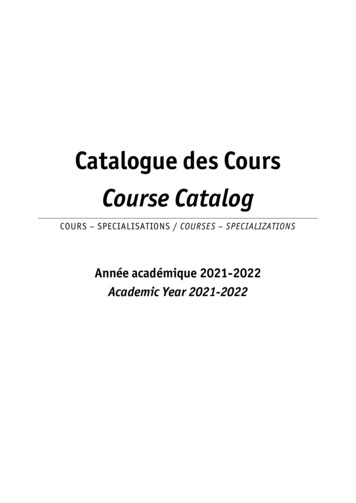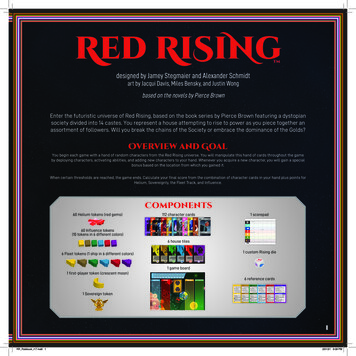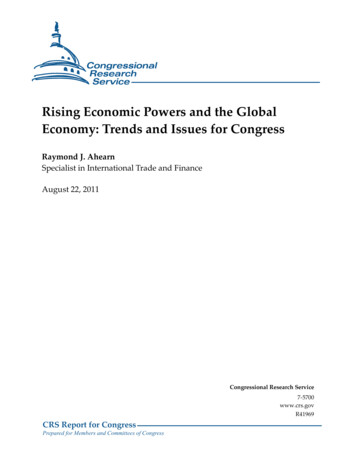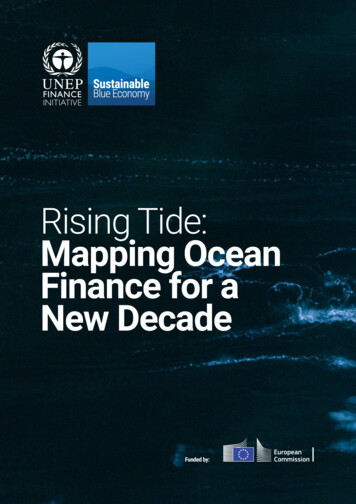
Transcription
Rising Tide:Mapping OceanFinance for aNew DecadeFunded by:Rising tide: Mapping ocean finance for a new decade 1
AcknowledgementsThe UN Environment Programme’s Sustainable Blue Economy Finance Initiative (UNEPFI SBE) is indebted to all members of the Sustainable Blue Economy Finance InitiativeWorking Group for their support in the development of this report.In addition, special thanks go to the following individuals for their review, contributionsand insights:Steven AdlerOcean Data AllianceLouise HeapsWWF UKMelissa WalshAsian Development BankFrançois GolberyESAFONNathanial MatthewsOcean Risk and ResilienceAction AllianceJacqueline WhartonWillis Towers WatsonAlexander HadzhiivanovEuropean Bank forReconstruction andDevelopmentRashid SumailaUniversity of British ColumbiaProject TeamKlaas de VosAuthorOcean Fox AdvisoryJessica SmithEcosystems LeadUNEP FIDennis FritschProject CoordinatorSustainable Blue EconomyFinanceUNEP FICara WilsonCommunications LeadBanking & EcosystemsUNEP FINicholas BruneauCommunicationsConsultantUNEP FIAdam GarfunkelEditorJunxion StrategyThis work was partially funded by the Swedish Government via the UN EnvironmentProgramme Sustainable Blue Economy Initiative.Finally, we also want to thank the Founding Partners of the Sustainable Blue EconomyFinance Principles for their continued support.WORLDRESOURCESRising tide: Mapping ocean finance for a new decadeAcknowledgementsINSTITUTE2
Table of ContentsAcknowledgements. 2Table of Contents.3Table of Figures. 5Foreword .6Executive summary.8Needs and opportunities.10Seafood. 11Ports. 11Maritime transportation. 12Coastal and marine tourism. 12Marine renewable energy. 12Recommendations. 13Introduction.15Context. 16What is the sustainable blue economy?. 17What do we mean by finance for the sustainableblue economy?.18How does this paper relate to the guidance?.18Structure. 19Overview of the current sustainable blue economy finance landscape.20Broad financing initiatives. 21EU taxonomy for sustainable activities. 21Taskforce on Climate-related Financial Disclosures (TCFD).22Taskforce on Nature-related Financial Disclosures (TNFD).24Specific financing initiatives.24Ocean Risk and Resilience Action Alliance (ORRAA).24Coalition for Private Investment in Conservation (CPIC).25IUCN Blue Natural Capital Finance Facility.26WTW Global Ecosystem Resilience Facility.26Capitals Coalition.27MDB financing initiatives.28Asian Development Bank’s Oceans Financing Initiative (OFI) and Healthy Ocean Action Plan.28World Bank PROBLUE multi-donor trust fund.29European Investment Bank’s Blue Sustainable Ocean Strategy.29Rising tide: Mapping ocean finance for a new decadeTable of Contents3
Knowledge and research initiatives .30High-Level Panel for a Sustainable Ocean Economy .30Friends of Ocean Action.30Planet Tracker Initiative.30Global Ocean Accounts Partnership. 31UN Global Compact Sustainable Ocean Business Action Platform . 31Gaps in the landscape. 32Survey results.34Audience profile.35Sector responses.40Seafood.43Ports.48Maritime transportation.52Coastal and marine tourism .56Marine renewable energy.60Recommendations for guidance development .64Annex: Additional survey responses and results. 71Seafood .74Ports.75Maritime transportation.76Coastal and marine tourism. 77Marine renewable energy. 77Rising tide: Mapping ocean finance for a new decadeTable of Contents4
Table of FiguresFigure 1:Figure 2:Figure 3:Figure 4:Figure 5:Figure 6:Figure 7:Figure 8:Figure 9:Figure 10:Figure 11:Figure 12:Figure 13:Figure 14:Figure 15:Figure 16:Figure 17:Figure 18:Figure 19:Figure 20:Figure 21:Figure 22:Figure 23:Figure 24:Figure 25:Figure 26:Figure 27:Figure 28:Figure 29:Figure 30:Figure 31:EU taxonomy overview. 22Capitals Coalition capital types. 27Focus analysis of major finance initiatives and their relevanceto the blue economy.33What type of institution do you represent?.35Are you familiar with the sustainable blue economy?. 36Where is your institution active in the sustainable blue economy?. 37How are the sectors of the sustainable blue economy financed?.38How source regions invest in the blue economy. 39Proportion of respondents providing financial servicesfor key blue economy sectors.40Percentage split of sum of greatest reported risks across sectors. 41Sum of most important non-financial considerations across sectors. 42Where do you see the wild-caught fisheries sector 10 years from now?.43Where do you see the aquaculture sector 10 years from now?.43Predicted key trends in fisheries 2020–2030.44Predicted key trends in aquaculture 2020–2030.44Where do you see the port sector 10 years from now?.48Predicted key trends in ports 2020–2030. 49Where do you see the maritime transportation sector 10 years from now?. 52Predicted key trends in maritime transportation 2020–2030.53Where do you see the coastal and marine tourism sector10 years from now? . 56Predicted key trends in coastal and marine tourism 2020–2030. 57Which sub-sectors of marine renewable energy do you work with?.60Where do you see the marine renewable energy sector10 years from now? . 61Predicted key trends in marine renewable energy 2020–2030. 61Within your institution, which of the following best describes your role?. 72Different sectors are financed by different institutions.73Which financial products does your organisation typicallywork within the seafood sector?.74Which financial products does your organisation typicallywork with in the ports sector?.75Which financial products does your organisation typicallywork with in the maritime transportation sector?. 76Most common financial instruments in coastal and marinetourism sector. 77Which financial products does your organisation typicallywork with in the marine renewable energy sector?.78Rising tide: Mapping ocean finance for a new decadeTable of Figures5
Foreword‘How inappropriate to call this planet Earth, whenclearly it is Ocean.’Quote commonly attributed to Arthur C. Clarke, AuthorThe majority our planet is covered by a vast blue expanse, holding 97% of all our waterand 80% of all life forms. The ocean surrounds us and sustains us, providing the oxygenfor every second breath we take, food for almost half of humanity, and critical resourcesfor human health, leisure and energy production. Major industries such as shipping, ports,coastal tourism, fishing, aquaculture and offshore renewables depend on the ocean andimpact it through their activities. This ‘blue’ economy, estimated by the OECD at a globalgross value added of USD 1.5trn in 2010, has been projected to increase to USD 3trn by2030, with some ocean industries set to grow faster than the global economy.The blue economy must be wholly sustainable, it must encompass environmentalstewardship. Already the ocean is at breaking point, faced with the triple crises of pollution, nature loss and climate change. More than a third of fish stocks globally are overexploited and almost 60% are fished at their maximum sustainable limit, only 10-30% ofcoral reefs are expected to survive a climate that warms to 1.5 C above pre-industriallevels (virtually all would be lost under a 2 C scenario), and marine life is being extensively damaged by plastic pollution and chemical run-off from our land-based industries.The tide of ocean-related issues is rising. It’s time to build a new relationship with thisvital ecosystem, and urgently build sustainability into ocean-linked sectors.Banks, insurers and investors have a major role to play in financing the transition to asustainable blue economy, helping to rebuild ocean prosperity and restore biodiversity tothe ocean. Through their lending, underwriting and investment activities, as well as theirclient relationships, financial institutions have the power to accelerate and mainstreamthe sustainable transition of ocean-linked industries.This is why, in 2018, we launched the Sustainable Blue Economy Finance Principles. Aworld-first, these guiding principles remain a keystone in the market, designed for financiers to align their activities with Sustainable Development Goal 14, ‘life below water’.By following these Principles, and building sustainable blue practices into their decision-making processes, the financial sector has a unique opportunity and a clear imperative to steer the ocean economy towards sustainability. Investments that are sustainablewill thrive, while those that are unsustainable risk failure and loss.Rising tide: Mapping ocean finance for a new decadeForeword6
This new report sees the United Nations build on these Principles, mapping the currentstate of ocean finance and the transition required at the start of the UN Decades of OceanScience for Sustainable Development and Ecosystem Restoration. The report revealsthe current trends in lending, underwriting and investment activities which impact theocean, the frameworks and financial instruments that are successfully addressing oceansustainability, and highlights new opportunities and gaps in the market. It looks acrossfive key ocean sectors, chosen for their established connection with private finance.This Report will be followed by practical Guidance to be launched later this year,designed to bring clear direction and detailed recommendations for financial decision-makers on how to sustainably engage with five major ocean-linked sectors; seafood,ports, maritime transport, coastal and marine tourism and marine renewable energy.This trailblazing Guidance will provide a detailed breakdown of which client activitiesto seek out as best-practice, which activities to challenge, and which activities to avoidfinancing altogether due to their damaging nature.We believe that wide adoption of the Principles and Guidance will allow the financialsector to take ambitious steps to reshape the ocean landscape and provide a coursecorrection towards a sustainable blue economy. We invite banks, insurers and investors to join over 50 pioneering organisations who are members of the Sustainable BlueEconomy Finance Initiative to help shape the future of sustainable blue finance and toadopt and implement the Sustainable Blue Economy Finance Principles. Together wecan meet the rising tide.Founders of the Sustainable Blue Economy Finance PrinciplesWORLDRESOURCESINSTITUTEThe UN Environment Programme’s Sustainable Blue Economy Finance Initiative works with banks, insurersand investors to build industry-wide guidance and standards for sustainably financing ocean sectors. Withover 50 pioneer institutions already onboard, we invite interested parties to join the global community ofpractice and take a leadership role in shaping the future of financing the blue economy. Find out more.Rising tide: Mapping ocean finance for a new decadeForeword7
Executive summaryBanks, insurers and investors have a crucial role to play in the transition towards asustainable blue economy (SBE). To help guide them, the European Commission, European Investment Bank, WWF and the World Resources Institute launched the Sustainable Blue Economy Finance Principles in 2018.Building on the momentum of these principles, the United Nations EnvironmentProgramme Finance Initiative (UNEP FI) hosts the Sustainable Blue Economy FinanceInitiative (SBEFI), a new platform bringing together financial institutions to work withscientists, corporates and civil society to facilitate the adoption and implementation ofthe Sustainable Blue Economy Finance Principles, ensuring they become operationaland useful for financial institutions worldwide. The SBEFI seeks to achieve the following:Positively influence mainstream ocean-related investment, insurance and lending todrive development that underpins a sustainable blue economy; Catalyse finance sector engagement and practical action to deliver a sustainableblue economy and support the ambitions of SDG14 (Life Below Water); and Develop concrete actions and outputs for insurers, lenders and investors to alignlending, insurance and investment decisions with ocean health. To support the work of the SBEFI, this report aims to create clarity around the state offinancing for the sustainable blue economy, defining the concept of SBE finance andproviding an overview of its current status. It seeks to provide insight into the transitionrequired to realise financing for the SBE across the five key sectors that form the basisof the SBEFI’s initial focus: Seafood (including fisheries and aquaculture); Maritime transportation; Port development; Coastal and marine tourism; and Marine renewable energy.The report maps the current SBE financing landscape, highlighting existing initiativesand resources and identifying some of the key players and initiatives working alongside UNEP FI to build up financing for the sustainable blue economy. Crucially, it alsoconsiders some of the gaps in current focus where greater attention may be worthwhile (see overleaf). This leads into a discussion on needs and opportunities, examining where financial institutions and other stakeholders may play beneficial roles infinancing the sustainable blue economy.Rising tide: Mapping ocean finance for a new decadeExecutive summary8
xTotalxUNEP FI SBExFOAxHLPxSO4AWB PROBLUExUNGCADB oceanxGOAPCCxKnowledge and researchinitiativesPlanetTrackerGERFxEIB Blue SOSBNCFFMDBinitiativesCPICSpecific financeinitiativesORRAATCFDArea of focusEU g understandingDefining concepts and framing the issuexxPolicy frameworks and enabling conditionsxxxxxxData analysis and measurementxxCampaigning and/or engagementxxxxxxxxxxxx6x7Tools for the financial industryConcessional financing and seed investmentxDe-riskingxxReplicationxxDisclosure and reportingPrimary ocean focusRising tide: Mapping ocean finance for a new decadeExecutive xxxxxxxxxxxx6xxx6xxx99
The report then considers the results of an industry survey undertaken in September2020, which gauges the understanding and key considerations of banks, investors andinsurers in the sustainable blue economy. The responses to this survey underpin theinsights in this report and are described in detail in Chapter Three. Among the keyinsights from this survey is the breadth of instruments used by the institutions financing the sectors of the blue economy, as indicated in the chart below where each colourrepresents a different kind of financing instrument. This highlights that the sustainableblue economy is not ‘one size fits all’, and that a wide range of instruments may beused and applicable to the diversity of sectors and activities it comprises.Broad array of financial instruments used acrosssectors of the sustainable blue economyMarinerenewableenergyCoastal andmarine tourismMaritimetransportationPortsSeafoodNeeds and opportunitiesIt is evident from the survey results as well as recent literature (Responsible Investor,2020) that financial institutions see both significant risks and areas of impact in thesustainable blue economy. Similarly, many sectors of the SBE are predicted to grow inrelevance over the next 10 years. In light of both of these factors, the future development of the SBE features both clear needs to be addressed as well as opportunities tobe captured. As needs and opportunities are asymmetric and look different for different sectors of the blue economy, these are explored on a sector-by-sector basis in thisreport, building on the results from the survey.A number of resources have been developed to better understand some of the needsand opportunities in the sustainable blue economy (e.g. Friends of Ocean Action(2020), Sumaila et al (2020)). This report considers these for the five sectors of thesustainable blue economy guidance, alongside potential roles for financial institutionsto realise the SBE and case studies of current best practice and innovation.Rising tide: Mapping ocean finance for a new decadeExecutive summary10
SeafoodThere is a pressing need to move the remainder of the world’s fisheries from an unsustainable to a sustainable status. Currently 21.3% of the world’s fisheries remain over-exploited, which means the SDG target 14.4 to end overfishing by 2020 has not beenachieved (FAO, 2020). From a financing perspective, it is vital for mechanisms andinstitutions to pivot away from providing capital or insurance to companies active inover-exploited fisheries. This includes seeking out sustainability certification for fisheries and introducing new solutions for monitoring, control and surveillance (MCS) offishing effort and fisheries traceability.Uniquely among the sectors featured in this report, fisheries are predicted by surveyrespondents to become less prominent within the sustainable blue economy by 2030,as—on the current trajectory—the world’s wild fish stocks are maximised and aquaculture continues to grow to meet global seafood demand.In aquaculture, key concerns relate to reducing aquaculture’s negative impact on theenvironment while scaling up globally to meet demand for animal protein, particularlyamong the world’s emerging middle classes. Improvements in profitability and efficiency—notably through sustainable intensification and improvements in feed conversion and new commercially available species—are additional factors for the sustainedgrowth of aquaculture. For financial institutions, principal requirements to supportcontinued sustainable growth are: ensuring that overall production is sustainable,with minimal environmental impact; and managing disease outbreaks and concernsover invasive species within fish farms. As with fisheries, certification, when appliedeffectively is an important lever to move the sector towards sustainability, both at theproduction level and within the seafood supply chain, where wild-caught and farmedsources converge.PortsPorts impact on both terrestrial and marine ecosystems, and are particularly vulnerableto the impacts of climate change, and face physical risks from storm damage, coastalsubsidence and rising sea levels (UNCTAD, 2018). This suggests a need to modernisethe port sector globally to bring it in line with the targets of both the Paris Agreementand the Sustainable Development Goals. Resilient and green infrastructure is a potential avenue for financial institutions to explore to identify opportunities to develop amore sustainable port infrastructure. Particular opportunities may exist in the decarbonisation of the sector, the highest-reported trend for the current decade.Rising tide: Mapping ocean finance for a new decadeExecutive summary11
Maritime transportationClosely tied to the development of ports, maritime transportation is an important driverof global trade and the economy. Like ports, maritime transportation impacts on theenvironment in a number of ways, notably through air, water and noise pollution, therisk of introducing invasive species and collisions with wildlife. Maritime transportationhas been particularly impacted in recent years by the International Maritime Organisation’s decision to set a 50% decarbonisation target for the sector by 2050 to bringit in line with the Paris Agreement (IMO, 2018). The resultant needs for the maritimetransportation sector are tied closely to the broader objectives of decarbonisation—beit through retrofitting existing ships to use fuels with a lower emissions profile (HellenicShipping News, 2020); identifying ways to optimise maritime transportation efficiency(Armstrong, 2013); and innovating new ways of transporting cargo altogether, suchas reintroducing wind-powered propulsion (Zeldovich, 2020). Existing guidance forthe maritime transportation industry—notably the Poseidon Principles—offer a helpfulframework for moving the sector towards sustainability in line with global policy effortson sustainability and climate.Coastal and marine tourismThere is a clear need in the tourism industry to gain a better understanding of whatsustainability means (both for mainstream tourism as well as eco-tourism) and toscale up the adoption of standards for sustainability in tourism operations. To date,the Global Sustainable Tourism Council (GSTC) has taken a leading role in developing a common standard for sustainable tourism that is used throughout the industry.However, a notable absence from the GSTC’s standards at the present time is cruising,where benchmarks and regulations for sustainability vary greatly by jurisdiction andare often managed under the auspices of the IMO as adapted maritime transportation regulations. As an immediate contribution towards the scaling up of sustainabilityin the tourism sector, financial institutions can support the development of greaterawareness and use of sustainability benchmarks in the tourism industry by demandingsustainability certification in their financed transactions.Marine renewable energyFavourable regulation continues to be a key factor in the contribution of marine renewables to the energy mix. In northern Europe offshore wind is increasingly competitivewith non-renewable energy, but elsewhere there is a continued reliance on favourableregulation to enable investment and overcome the high costs of capital associatedwith the development of marine renewables. This creates a clear role for public institutions to provide the right conditions for renewables to thrive—notably in the context ofsubsidies for renewable energy generation.Rising tide: Mapping ocean finance for a new decadeExecutive summary12
As marine renewables grow in prominence, there is also a clear need for greater clarityaround their impacts on society and the environment as well as how they interact withother users of the marine environment. For example, increasing the level of knowledgeand understanding of the environmental impact of installing new wind turbines on theseabed is vital to ensuring that best practice can be developed.RecommendationsBased on the findings from this report’s survey and an assessment of the needs andopportunities for future development of the sustainable blue economy, a number ofrecommendations for the development of sector-specific guidance1 have emerged.1. Wherever possible, leverage existing guidance, standards and best practice forsustainability at the sectoral level. For several of the sectors covered in this report,substantial efforts have been made to codify best practice for sustainability withconsiderable uptake by industry. For example, the Global Sustainable Tourism Council (GSTC) standards and Poseidon Principles for maritime transportation haveparameterised sustainability on a number of key topics already. While the guidancebeing developed for the sustainable blue economy will target financial institutionsrather than sector-specific businesse
Rising tide: Mapping ocean finance for a new decade 7 Foreword This new report sees the United Nations build on these Principles, mapping the current state of ocean finance and the transition required at the start of the UN Decades of Ocean Science for Sustainable Development and Ecosystem Restoration. The report reveals

